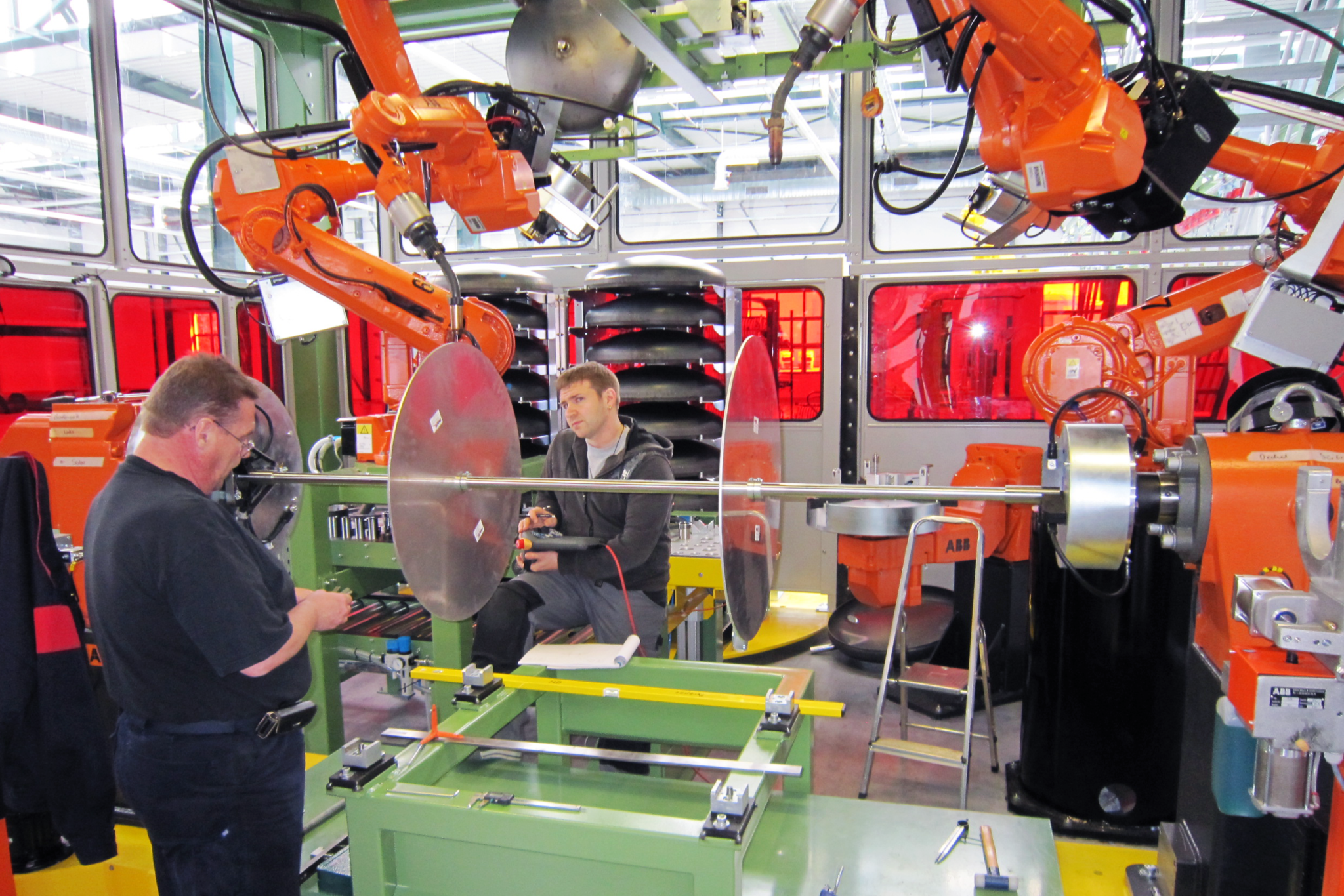07.12.2023
How do you become a Robotics Engineer in the world's largest Robotic Construction Laboratory?
Philippe Fleischmann is Head of Industrial Robotics and Automation at the Robotic Fabrication Lab (RFL) and part of the NCCR DFAB. This summer, he travelled to Ottawa (Canada) for a sabbatical to help set up a new lab as an expert in industrial robots. But how did it come about that Philippe, a trained automation engineer, is now an expert in industrial robots in the world's largest laboratory for digital fabrication?
Before Philippe Fleischmann worked with robots in the Robotic Fabrication Lab (RFL) at ETH Zurich, he worked in industry. He originally completed an apprenticeship as an automation engineer at Späni Elektromechanik AG, a local industrial company in Switzerland. "The invisibility of electricity and the logic behind it fascinated me even as a boy," he says. At the company where he completed his apprenticeship, he learnt the basic concepts of automation. "I was fascinated by the further development of complex industrial systems," says Philippe, "and so I acquired the knowledge to develop and programme these systems in a higher specialist training course." Back then, industrial robots were not yet a major topic in the construction industry, he recalls.
From Pulling Cables to Programming
Philippe learned how to program programmable logic controllers (PLCs): the theory at a part-time university of applied sciences specialising in automation, and in practice at Marti Engineering AG. "From pulling cables to programming," says Philippe and laughs. At Marti Engineering, a leading prototype machine manufacturer in Switzerland that develops customised end-effectors for ABB Robotics, among other things, he not only learned to programme, but also to develop highly complex prototypes for the automation industry. "During my work, I came into contact with one of the largest robot integrators in Switzerland, the partner company Marti Systeme AG." Philippe was immediately fascinated by the moving arms, the programming logic and the modern development environment, RobotStudio. "At the age of 26, I completed an internship at Marti Systeme and industrial robots have been at the centre of my work ever since."

Philippe Fleischmann working in Industry at Marti Systeme AG. Photo: Marti Systeme AG
A Laboratory for Digital Fabrication
In 2014, the Sequential Roof (2010-2016) at ETH Zurich, a robot-fabricated roof, was built by Erne Holzbau AG. This will have been Philippe's first contact with digital fabrication. Güdel, the gantry specialist and robot supplier for the challenging project, asked Philippe's employer at the time, Marti Systeme, for support in commissioning the customised gantry robot. "Through the collaboration with Erne Holzbau AG, Güdel and the start-up Rob Technologies from Gramazio Kohler Research (GKR), I also got to know the Robotic Fabrication Lab, a new type of research laboratory, for the first time. It was planned that Professors will later work there whose research would focus on digital fabrication, for example with robots." Philippe moved from industry to ETH in 2016 to dedicate himself to the huge prototype system with four robots and a large work area in the emerging RFL.
The Challenge of Software Communication
At ETH Zurich, Philippe met Professor Matthias Kohler (GKR). Matthias challenged him in 2018 with the "Spatial Timber Assemblies" project for the DFAB House Demonstrator (2016-2019). "Matthias asked whether it was possible to increase the production speed. In the research at the time," says Philippe, "the software communication was too slow at full robot speed and the movement of the robot came to a standstill. We needed a better solution to realise the potential of the industrial robot". Mastering industrial robots requires interdisciplinary experience in mechanics, electrical engineering, drive technology, programming technology and process understanding, which Philippe brought with him. "At Marti Systeme AG, I programmed systems with up to three coordinated robots and two external axes. At ETH, there are four robots with ten additional axes," says Philippe, his eyes lighting up.

Every new project in the lab helps Philippe to further develop his knowledge.
COMPAS_RRC: Full Potential for Industrial Robots in the Academy
It took Philippe three years and a major project on the scale of the DFAB HOUSE before he understood the control problem. Since then, together with Gonzalo Casas and Mike Lyrenmann at ETH, he has developed COMPAS_RRC, a tool that controls the robot’s movements and harmonises the production processes. The focus was on perfectly programmed and cycle time-optimised online communication. As a result, communication has been massively accelerated. “The orders and the specific parameters are controlled in the design environment and sent to the robot, which executes them accordingly and sends the process feedback back to the design environment,” explains Philippe. The Semiramis project (2020-2022) later provided proof that the communication can control the entire gantry robot with all external axes in a coordinated manner in automatic mode. “COMPAS_RRC is intended to build a bridge between research and industry,” says Philippe, describing the basic idea behind the innovative software package.

For the Semiramis project (Gramazio Kohler Research), four robots worked simultaneously in an unprecedented additive manufacturing process. Photo: Michael Buholzer / Keystone
COMPAS_RRC in the NCCR Digital Fabrication
The COMPAS_RRC software package helps researchers with process development. Philippe explains: “Thanks to COMPAS_RRC, it is now possible to utilize the full potential of ABB’s industrial robots and their process-specific system solutions (e.g., high-end welding equipment from Fronius) and integrate them into complex digital fabrication projects in relatively simple collaboration with the automation specialists." The NCCR DFAB also benefits from this: the software package has played and continues to play a central role in many projects such as the Concrete Choreography (2019), the Clay Rotunda (2021), Semiramis (2020-2022) and the Eggshell Pavilion (2021-2022). "The variety of projects has taught me a lot of new things, and I'm always learning new things," says Philippe. When he thinks back to the early days, a lot has happened since he joined the industry: "When the RFL was still in its infancy, there were five robots that the researchers worked with. Today, there are around 40 robots in the building." Interest in industrial robotics in the construction industry has also increased, not only in Switzerland but worldwide.
COMPAS_RRC Competence Centre in Canada
The result is that COMAS_RRC is already being used by 13 different organisations in six countries around the world and has been installed in over 50 real-world systems with licences. Thanks to Philippe, COMPAS_RRC found its way to Canada this summer, to the Carleton Sensory Architecture and Liminal Technologies (CSALT) Lab at Carleton University. The CSALT Lab is directed by Professor Sheryl Boyle. She and her team are researching new technologies in design for manufacturing and assembly. With the support of Philippe, the researchers have developed processes beginning in the Rhino/Grasshopper design environment and utilize feedback based process development in Python with COMPAS_RRC to achieve multi-robot control. With Adonis Lau, a contact person for COMPAS_RRC has been added in Canada (see info box).
COMPAS_RRC as a Link between Industry and Science
A workshop planned for 21 to 23 May 2024 during the international ROB|ARCH conference in Toronto, Canada demonstrates the ongoing interest and importance of COMPAS_RRC for global research and development. "The workshop in the field of digital fabrication is hopefully another piece of the puzzle in the collaboration between industry and academia," says Philippe. Philippe hopes that the extended collaboration will lead to new efficient product solutions for the construction industry.

COMPAS_RRC is used in the Carleton Sensory Architecture and Liminal Technologies (CSALT) Lab at Carleton University.
Adonis Lau from Carleton University is the contact person for COMPAS_RRC in Canada. He is part of the CSALT lab and leads the research in coding at the lab. Please contact Adonis by email: AdonisLau@cmail.carleton.ca


